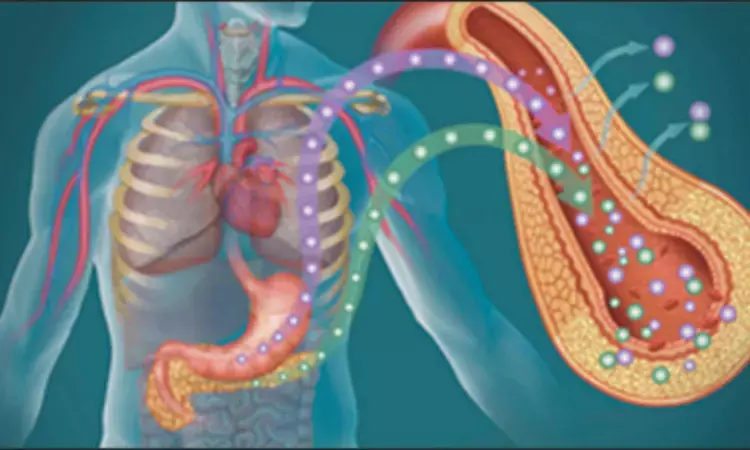- Home
- Medical news & Guidelines
- Anesthesiology
- Cardiology and CTVS
- Critical Care
- Dentistry
- Dermatology
- Diabetes and Endocrinology
- ENT
- Gastroenterology
- Medicine
- Nephrology
- Neurology
- Obstretics-Gynaecology
- Oncology
- Ophthalmology
- Orthopaedics
- Pediatrics-Neonatology
- Psychiatry
- Pulmonology
- Radiology
- Surgery
- Urology
- Laboratory Medicine
- Diet
- Nursing
- Paramedical
- Physiotherapy
- Health news
- Fact Check
- Bone Health Fact Check
- Brain Health Fact Check
- Cancer Related Fact Check
- Child Care Fact Check
- Dental and oral health fact check
- Diabetes and metabolic health fact check
- Diet and Nutrition Fact Check
- Eye and ENT Care Fact Check
- Fitness fact check
- Gut health fact check
- Heart health fact check
- Kidney health fact check
- Medical education fact check
- Men's health fact check
- Respiratory fact check
- Skin and hair care fact check
- Vaccine and Immunization fact check
- Women's health fact check
- AYUSH
- State News
- Andaman and Nicobar Islands
- Andhra Pradesh
- Arunachal Pradesh
- Assam
- Bihar
- Chandigarh
- Chattisgarh
- Dadra and Nagar Haveli
- Daman and Diu
- Delhi
- Goa
- Gujarat
- Haryana
- Himachal Pradesh
- Jammu & Kashmir
- Jharkhand
- Karnataka
- Kerala
- Ladakh
- Lakshadweep
- Madhya Pradesh
- Maharashtra
- Manipur
- Meghalaya
- Mizoram
- Nagaland
- Odisha
- Puducherry
- Punjab
- Rajasthan
- Sikkim
- Tamil Nadu
- Telangana
- Tripura
- Uttar Pradesh
- Uttrakhand
- West Bengal
- Medical Education
- Industry
MAFLD Shows Stronger Association with Diabetes and Hypertension Than NAFLD and MASLD: Study Finds

China: A recent study published in BMC Gastroenterology highlights the differing risks associated with various types of fatty liver disease and their links to metabolic disorders.
"The comparative analysis of MASLD, MetALD, MAFLD, and NAFLD showed that MAFLD had the strongest link to metabolic disorders, including type 2 diabetes (OR 7.02), hypertension (OR 3.45), and hyperlipidemia. MASLD and NAFLD followed, with diabetes risk ORs of 6.30 and 3.37, respectively," the researchers reported. "Moderate-to-severe liver steatosis further elevated diabetes risk across all categories, reinforcing MAFLD’s potential as a reliable predictor of metabolic dysfunction."
The research, conducted by Hong-ye Peng and colleagues from the Graduate School at Beijing University of Chinese Medicine, compared clinical characteristics and relative metabolic risk in individuals diagnosed with Metabolic dysfunction-associated steatotic liver disease (MASLD), Metabolic alcohol-related liver disease (MetALD), Metabolic associated fatty liver disease (MAFLD), and Nonalcoholic fatty liver disease (NAFLD).
Using data from the National Health and Nutrition Examination Survey (NHANES) 2017–2018 cycle, the team analyzed a cohort of 1,862 individuals to assess the associations between these liver disease classifications and common metabolic conditions such as type 2 diabetes mellitus (T2DM), hypertension, and hyperlipidemia.
The study led to the following findings:
- MAFLD showed the strongest association with type 2 diabetes (OR 7.02), followed by MASLD (OR 6.36) and NAFLD (OR 3.37).
- For hypertension, MAFLD again had the highest correlation (OR 3.46), followed by MASLD (OR 2.89), NAFLD (OR 1.98), and MetALD (OR 1.80).
- MAFLD emerged as a more accurate clinical marker for assessing metabolic risk than other liver disease definitions.
- Moderate to severe liver steatosis significantly increased the risk of type 2 diabetes across all groups.
- Patients with MASLD and advanced steatosis had an OR of 3.92 for T2DM; MAFLD and NAFLD groups showed similar risks with ORs of 3.81 and 4.91, respectively.
- Individuals with MASLD or MetALD typically had higher BMI and greater metabolic dysfunction, highlighting the need for early detection and monitoring.
The authors conclude that the newer definitions of MASLD and MetALD are clinically relevant and merit continued investigation. However, MAFLD, due to its strong link with metabolic complications and steatosis severity, stands out as a more effective screening tool for identifying high-risk individuals. These insights could help refine diagnostic criteria and improve preventive strategies in metabolic and liver disease management.
“MAFLD shows greater predictive value in identifying individuals at increased risk for common metabolic disorders,” the researchers noted, underscoring the potential utility of this classification in guiding future clinical decision-making.
Reference:
Peng, Hy., Lu, Cl., Zhao, M., et al. Clinical characteristics of MASLD/MetALD/MAFLD/NAFLD and the relative risk analysis on metabolic disorders. BMC Gastroenterol 25, 372 (2025). https://doi.org/10.1186/s12876-025-03912-0
Dr Kamal Kant Kohli-MBBS, DTCD- a chest specialist with more than 30 years of practice and a flair for writing clinical articles, Dr Kamal Kant Kohli joined Medical Dialogues as a Chief Editor of Medical News. Besides writing articles, as an editor, he proofreads and verifies all the medical content published on Medical Dialogues including those coming from journals, studies,medical conferences,guidelines etc. Email: drkohli@medicaldialogues.in. Contact no. 011-43720751


